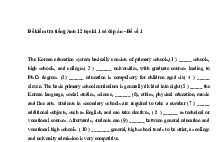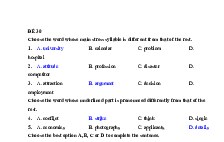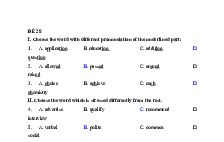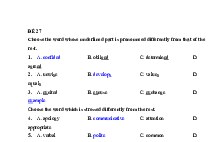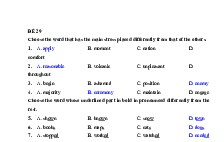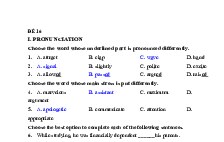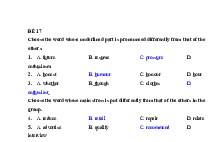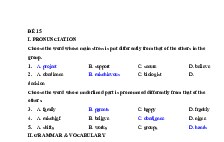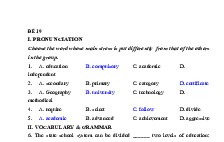5. Đề thi thử TN THPT 2021 - Môn Tiếng Anh - Bộ đề chuẩn cấu trúc minh họa - Đề 5 - File word có lời giải
Nội dung tài liệu
Tải xuống
Link tài liệu:
Các tài liệu liên quan
-
![Đề thi học kì 1 Tiếng anh lớp 12 năm 2020-2021 ĐỀ SỐ 2]()
-
![Đề thi học kì 1 Tiếng anh lớp 12 năm 2020-2021 ĐỀ SỐ 1]()
-
![Đề thi học kì 1 Tiếng anh lớp 12 năm 2020-2021 ĐỀ SỐ 30]()
-
![Đề thi học kì 1 Tiếng anh lớp 12 năm 2020-2021 ĐỀ SỐ 28]()
-
![Đề thi học kì 1 Tiếng anh lớp 12 năm 2020-2021 ĐỀ SỐ 27]()
-
![Đề thi học kì 1 Tiếng anh lớp 12 năm 2020-2021 ĐỀ SỐ 29]()
-
![Đề thi học kì 1 Tiếng anh lớp 12 năm 2020-2021 ĐỀ SỐ 16]()
-
![Đề thi học kì 1 Tiếng anh lớp 12 năm 2020-2021 ĐỀ SỐ 17]()
-
![Đề thi học kì 1 Tiếng anh lớp 12 năm 2020-2021 ĐỀ SỐ 15]()
-
![Đề thi học kì 1 Tiếng anh lớp 12 năm 2020-2021 ĐỀ SỐ 14]()
Có thể bạn quan tâm
Thông tin tài liệu
SỞ GIÁO DỤC VÀ ĐÀO TẠO
ĐỀ CHUẨN MINH HỌA 05
(Đề thi có 04 trang)
KỲ THI TỐT NGHIỆP TRUNG HỌC PHỔ THÔNG NĂM 2021
Bài thi: NGOẠI NGỮ; Môn thi: TIẾNG ANH
Thời gian làm bài: 60 phút không kể thời gian phát đề
-------------------------Họ, tên thí sinh:…………………………………………………………………………
Số báo danh:....................................................................................................................
Mark the letter A, B, C, or D on your answer sheet to indicate the word whose underlined part differs
from the other three in pronunciation in each of the following questions.
Question 1 .
A. shortlist
B. temporary
C. afford
D. accordingly
Question 2.
A. waited
B. decided
C. cooked
D. contaminated
Mark the letter A, B, C, or D on your answer sheet to indicate the word that differs from the
Question 3.
A. confide
B. gather
C. divide
D. maintain
Question 4.
A. compulsory
B. certificate
C. category
D. accompany
Mark the letter A, B, C, or D on your answer sheet to indicate the correct answer to each of the following
questions.
Question 5. He went to Ha noi yesterday , ___?
A. doesn’t he
B. did he
C. does he
D. didn’t he
Question 6. The road to our village . . . . . . . . next year.
A. is widened
B. will widened
C. can widened
D. will be widened
Question 7. He suffers .......... headaches.
A. from
B. with
C. in
D. by
Question 8. The more he slept,…………….irritable he became.
A. the most
B. the vey more
C. much more
D. the more
Question 9. My aunt gave me a hat on my 16th birthday.
A. nice yellow new cotton
B. new nice cotton yellow
C. new nice yellow cotton
D. nice new yellow cotton
Question 10: I saw Lisa at the museum when I ________ to restaurant.
A. was going
B. went
C. have gone
D. was going
Question 11. _______ he had enough money, he refused to buy a new car.
A. In spite
B. Although
C. Despite
D. In spite of
Question 12: , . his employees will have worked for two hours.
A. By the time the boss arrives
B. when the boss arrives
C. after the boss arrives
D. only when the boss arrives
Question 13:
every major judo title, Mark retired from international competition.
A. When he won
B. Having won
C. On winning
D. Winning
Question 14: In spite of her abilities, Laura has been
overlooked for promotion.
A. repeat
B. repeatedly
C. repetitive
D. repetition
Question 15: Some high school students often_____helping the disadvantaged or handicapped
children.
A. look after
B. clean up
C. make out
D. participate in
Question 16: A few kind words at the right time
all the difference.
A. make
B. give
C. do
D. take
Question 17. She made a big____________about not having a window seat on the plane.
A. fuss
B. complaint
C. interest
D. excitement
Question 18 I’ve never really enjoyed going to the ballet or the opera; they’re not really my_______.
A. piece of cake
B. sweets and candy C. biscuit
D. cup of tea
Question 19: Tony and Toby have a lot in
with each other.
A. common
B. competition
C. regard
D. similar
Mark the letter A, B, C, or D on your answer sheet to indicate the word(s) CLOSEST in meaning to the
underlined word(s) in each of the following questions.
Question 20: Around 150 B.C. the Greek astronomer Hipparchus developed a system to classify stars
according to brightness.
A. record
B. shine
C. categorize
D. diversify
Question 21: Before the advent of the railways, communications were slow and difficult.
A. import
B. disappearance
C. introduction
D. arrival
Mark the letter A, B, C, or D on your answer sheet to indicate the word(s) OPPOSITE in meaning to the
underlined word(s) in each of the following questions.
Question 22: Unless the two signatures are identical, the bank won’t honour the check.
A. genuine
B. different
C. fake
D. similar
Question 23: She’s a bit down in the dumps because she’s got to take her exam again.
A. sad
B. embarrassed
C. confident
D. happy
Mark the letter A, B, C, or D on your answer sheet to indicate the option that best completes each of the
following exchanges.
Question 24: - A: “Would you like me to send this package for you?” - B: “______”
A. That would be nice. Any problems?
B. Yes, please, if you don’t mind.
C. I’m sorry, but here you are.
D. No, thanks. I’m really busy.
Question 25: Nancy and James are talking about their school days.
– Nancy: "I think school days are the best time of our lives." – James:
. We had sweet
memories together then."
A. Absolutely
B. That's nonsense
C. I'm afraid so
D. I doubt it
Read the following passage and mark the letter A, B, C, or D on your answer sheet to indicate the correct
word or phrase that best fits each of the numbered blanks from 26 to 30.
Christ the Redeemer is an Art Deco statue of Jesus Christ in Rio de Janeiro, Brazil, created by PolishFrench sculptor Paul Landowski and built by the Brazilian engineer Heitor da Silva Costa, in collaboration
with the French engineer Albert Caquot. The face was created by the Romanian (26) ______ Gheorghe
Leonida. The statue is 30 metres tall, not including its 8-metre pedestal, and its arms stretch 28 metres wide.
By (27) ______ , it is approximately two-thirds the height of the Statue of Liberty’s height from base to
torch.
The statue weighs 635 metric tons (625 long, 700 short tons), and is (28) ______ at the peak of the
700-metre Corcovado mountain in the Tijuca Forest National Park overlooking the city of Rio. A symbol of
Christianity across the world, the statue has also become a cultural icon of both Rio de Janeiro and Brazil,
and is listed as (29) ______ of the New Seven Wonders of the World. The statue, (30) ______ was
constructed between 1922 and 1931, is made of reinforced concrete and soapstone.
(Adapted from https://world.new7wonders.com/)
Question 26:
A. artist
B. guitarist
C. stylist
D. scientist
Question 27:
A. package
B. comparison
C. pleasure
D. occasion
Question 28:
A. connected
B. scratched
C. located
D. pointed
Question 29:
A. other
B. each
C. another
D. one
Question 30:
A. why
B. which
C. who
D. that
Read the following passage and mark the letter A, B, C, or D on your answer sheet to indicate the correct
answer to each of the questions from 31 to 35.
The relationship between Britain and the US has always been a close one. Like all close relationships
it has had difficult times. The US was first a British colony, but between 1775 and 1783 the US fought a war
to become independent. The US fought the British again in the War of 1812.
In general, however, the two countries have felt closer to each other than to any other country, and
their foreign policies have shown this. During World War I and World War II, Britain and the US supported
each other. When the US looks for foreign support, Britain is usually the first country to come forward and
it is sometimes called “the 51st state of the union”.
But the special relationship that developed after 1945 is not explained only by shared political
interests. An important reason for the friendship is that the people of the two countries are very similar.
They share the same language and enjoy each other's literature, films and television. Many Americans have
British ancestors, or relatives still living in Britain. The US government and political system is based on
Britain's, and there are many Anglo-American businesses operating on both sides of the Atlantic. In Britain
some people are worried about the extent of US influence, and there is some jealousy of its current power.
The special relationship was strong in the early 1980s when Margaret Thatcher was Prime Minister in
Britain and Ronald Reagan was President of the US.
(Adapted from Background to British and American Cultures)
Question 31: What is the passage mainly about?
A. The strong friendship between the UK and the US.
B. The close relationship between Britain and the US.
C. A special relationship the UK developed during the World Wars.
D. A special influence the US had on the UK during the World Wars.
Question 32: The phrase "come forward” in paragraph 2 mostly means _______.
A. be willing to help B. be able to help
C. be reluctant to help D. be eager to help
Question 33:The word “They” in paragraph 3 prefers to __________.
A. countries
B. people
C. political interests D. British ancestors
Question 34: Which of the following is NOT mentioned as a reason for the special relationship between
Britain and the US?
A. The people of the two countries are very similar.
B. Many Americans have British ancestors.
C. British Prime Minister and the US President are close friends.
D. Many Anglo-American businesses are operating in the two countries.
Question 35: Britain and the US are close to each other NOT because of their ___________.
A. foreign policies
B. power
C. political interests D. language
Read the following passage and mark the letter A, B, C, or D on your answer sheet to indicate the
correct answer to each of the questions from 43 to 50.
There are two basic types of glaciers, those that flow outward in all directions with little regard for
any underlying terrain and those that are confined by terrain to a particular path.
The first category of glaciers includes those massive blankets that cover whole continents, appropriately
called ice sheets. There must be over 50,000 square kilometers of land covered with ice for the glacier to
qualify as an ice sheet, when portions of an ice sheet spread out over the ocean, they form ice shelves.
About 20,000 years ago the Cordilleran Ice sheet covered nearly all the mountains in southern Alaska,
western Canada, and the western United States. It was about 3 kilometers deep at its thickest point in
northern Alberta. Now there are only two sheets left on Earth, those covering Greenland and Antarctica.
Any domelike body of ice that also flows out in all directions but covers less than 50,000 square
kilometers is called an ice cap. Although ice caps are rare nowadays, there are a number in northeastern
Canada, on Baffin Island, and on the Queen Elizabeth Islands.
The second category of glaciers includes those of a variety of shapes and sizes generally called
mountain or alpine glaciers. Mountain glaciers are typically identified by the landform that controls their
flow. One form of mountain glacier that resembles an ice cap in that it flows outward in several directions
is called an ice field. The difference between an ice field and an ice cap is subtle. Essentially, the flow of
an ice field is somewhat controlled by surrounding terrain and thus does not have the domelike shape of a
cap. There are several ice fields in the Wrangell. St. Elias, and Chugach mountains of Alaska and northern
British Columbia.
Less spectacular than large ice fields are the most common types of mountain glaciers: the cirque
and valley glaciers. Cirque glaciers are found in depressions in the surface of the land and have a
characteristic circular shape. The ice of valley glaciers, bound by terrain, flows down valleys, curves
around their corners, and falls over cliffs.
Question 36: what does the passage mainly discuss?
A. Where major glaciers are located
B. How glaciers shape the land
C. The different kinds of glaciers
D. How glaciers are formed
Question 37: The word “terrain” in paragraph 1 could best be replaced by____________.
A. the seabed
B. area of land
C. countryside
D. prairie
Question 38: It can be inferred from paragraph 2 that ice sheets are so named because____________
A. they are thicker in some areas than the others
B. they are identified by the landform that controls their flow
C. they cover large areas of land
D. they are confined to cirque glaciers
Question 39: According to the passage, where was the Cordilleran Ice Sheet thickest?
A. Alaska
B. Antarctica
C. Greenland
D. Alberta
Question 40: The word “subtle” in paragraph 5 could best be replaced by____________.
A. slight
B. substantial
C. regional
D. obvious
Question 41: The word “their” in last paragraph refers to____________.
A. ice fields
B. cirque glaciers
C. valley glaciers
D. valleys
Question 42: All of the following are alpine glaciers EXCEPT____________.
A. cirque glaciers
B. ice caps
C. ice fields
D. Valley glaciers
Mark the letter A, B, C, or D on your answer sheet to indicate the underlined part that needs correction in
each of the following questions.
Question 43: My brother usually asked me for help when he has difficulty with his homework.
A
B
C
D
Question 44: They are having her house painted by a construction company.
A
B
C
D
Question 45: I’m becoming increasingly forgetable. Last week I locked myself out of the house twice.
A
B
C
D
Mark the letter A, B, C, or D on your answer sheet to indicate the sentence that is closest in meaning to
each of the following questions.
Question 46: We have been cooking for the party for four hours.
A. We didn’t start cooking for the party until four.
B. We started cooking for the party four hours ago.
C. We have four cooks for the party
D. Cooking for the party will be done in four hours
Question 47: "Don't forget to submit your assignments by Thursday," said the teacher to the students.
A. The teacher reminded the students to submit their assignments by Thursday.
B. The teacher allowed the students to submit their assignments by Thursday.
C. The teacher ordered the students to submit their assignments by Thursday.
D. The teacher encouraged the students to submit their assignments by Thursday.
Question 48: I’m sure that they had practiced hard for the games as they won a lot of medals.
A. They couldn’t have practiced hard for the games as they won a lot of medals
B. They must have practiced hard for the games as they won a lot of medals
C. They shouldn’t have practiced hard for the games as they won a lot of medals
D. They might have practiced hard for the games as they won a lot of medals.
Mark the letter A, B, C, or D on your answer sheet to indicate the sentence that best combines each pair
of sentences in the following questions
Question 49: Jenifer rejected the job offer. She now regrets it.
A. Jenifer regrets not having rejected the job offer.
B. If only Jenifer didn’t reject the job offer.
C. Jenifer wishes she hadn’t rejected the job offer.
D. Jenifer regrets to reject the job offer.
Question 50: We couldn't solve the problem until our teacher arrived.
A. Not until we solved the problem could our teacher arrive.
B. When our teacher arrived, we solved the problem.
C. Until our teacher arrived, we were able to solve the problem.
D. Not until our teacher arrived could we solve the problem.
ĐÁP ÁN
1-B
2-C
3-B
4-C
5-B
6-D
7-A
8-D
9-D
10-A
11-B
12-A
13-B
14-B
15-D
16-A
17-A
18-D
19-A
20-C
21-D
22-B
23-D
24-B
25-A
26-A
27-B
28-C
29-D
30-B
31-B
32-A
33-B
34-C
35-B
36-C
37-B
38-C
39-D
40-A
41-D
42-B
43-A
44-B
45-B
46-B
47-A
48-B
49-C
50-D
HƯỚNG DẪN GIẢI CHI TIẾT
Question 1: B
Câu 1: Đáp án B:BrE /ˈtemprəri/ ; NAmE /ˈtempəreri/
A. /ˈʃɔːtlɪst/
C. /əˈfɔːd/
D. /əˈkɔːdɪŋli/
Question 2: C
waited /ˈweɪtɪd/
decided /dɪˈsaɪdɪd/
cooked /kʊkt/
contaminated /kənˈtæmɪneɪtɪd/
Từ gạch chân trong câu C phát âm là/ t/còn lại đọc là /ɪd/ Chọn C
Question 3: B
Question 4: C
Từ “category” có trọng âm rơi vào âm tiết thứ nhất
Các từ còn lại có trọng âm rơi vào âm tiết thứ hai
Question 5 Đáp án B
Kiến thức: Câu hỏi đuôi
Giải chi tiết:
Vế trước câu hỏi đuôi mang nghĩa khẳng định (didn’t go) => câu hỏi đuôi ở dạng phủ định => loại B, C
đơn => thì ở câu hỏi đuôi dùng quá khứ đơn => loại A
Tạm dịch: Hôm qua anh ấy đi Hà nội , đúng không?
Question 6 D
Phương pháp giải:
Kiến thức: Câu bị động:
Giải chi tiết: Câu bị động thì Tương lai đơn. Hành động được nhấn mạnh con đườngđược mở rộng
S + will be + V-ed/V3
B, C sai ngữ pháp =>loại
Trạng từ chỉ thời gian ở tương lai “ next year” => Loại A vì chia động từ ở thì hiện tại đơn
Tạm dịch : Laura được sinh ra ở Boston.
Question 7 A
Phương pháp giải: Kiến thức: Giới từ chỉ nơi chốn
Giải chi tiết:
from: từ đâu, do thứ gì
with : cùng với => dùng khi chỉ muốn nhắc đến sự hiện , sự có mặt của ai đó tại đâu đó (không chú ý đến vị
trí cụ thể)
about : biết về ai
to :đối với ai
In : ở trong
By: bởi ai
Tạm dịch: Những sự việc này có lẽ quen thuộc với bạn
Đáp án : A
Question 8 D
Kiến thức: So sánh kép
Giải thích:
Cấu trúc so sánh kép: The + so sánh hơn + S + V, the + so sánh hơn + S + V (càng... càng...) nên phải dùng
“The more”
Đáp án : D
Question 9: D
Trật tự của các tính từ:
OpSACOMP: Opinion (Ý kiến) ; Size (Kích cỡ) ; Age (Tuổi) ; Shape (Hình dạng) ; Color (Màu sắc) ;
Origin (Xuất xứ) ; Material (Chất liệu) ; Purpose (Công dụng)
Tạm dịch: Bác của tôi tặng tôi một chiếc mũ bông màu vàng, rất mới và đẹp vào sinh nhật lần thứ 16.
Đáp án. D
Question 10: A
Kiến thức: Thì trong tiếng Anh
Kiến thức: Sự phối hợp về thì của động từ
Giải thích: Thì quá khứ đơn và quá khứ tiếp diễn kết hợp trong câu: Diễn tả hành động đang xảy ra trong
quá khứ thì một hành động khác xen vào, hành động đang xảy ra chi thì quá khứ tiếp diễn, hành động xen
vào chia thì quá khứ đơn
Tạm dịch:
Tôi đã nhìn thấy Lisa ở Viện Bảo Tàng , khi tôi đang đi đến nhà hàng.
Question 11. B
Kiến thức: Mệnh đề nhượng bộ
Giải thích:
Although + mệnh đề: cho dù, mặc dù
Despite/In spite of + danh từ/cụm danh từ: cho dù, mặc dù
Tạm dịch: Dù anh ấy có đủ tiền, anh ấy từ chối mua xe mới.
Question 12: A
Kiến thức: Mệnh đề chỉ thời gian / Sự hòa hợp thì trong mệnh đề
Giải thích:
Mệnh đề chính chia thì tương lai => động từ trong mệnh đề chỉ thời gian chia thì hiện tại (hiện tại đơn, hiện
tại hoàn thành).
Loại luôn được các phương án B, C, D do sai thì.
by the time: cho đến khi
only when: khi
after” sau khi
when: khi
Tạm dịch: vào lúc ông chủ đến, công nhân của ông ta sẽ làm việc được 2 giờ.
Question 13. B
Kiến thức: Mệnh đề đồng chủ ngữ
Giải thích: Khi đồng chủ ngữ ở dạng chủ động, ta sử dụng cấu trúc: Having done +…, S + V +…
Tạm dịch: Giành được mọi danh hiệu Judo lớn, Mark đã nghỉ hưu từ cuộc thi quốc tế.
Chọn B
Question 14.B
Kiến thức: Từ loại
Giải thích:
A. repeat (v): lặp lại
B. repeatedly (adv): một cách lặp lại
C. repetitive (adj): lặp lại
bổ nghĩa.
D. repetition (n): sự lặp lại Trước động từ “overlooked” ta cần một trạng từ để
Tạm dịch: Mặc cho khả năng của mình, Laura liên tục bị bỏ qua việc thăng chức.
Question 15 D
Kiến thức về cụm động từ
A. look after: chăm sóc, trông nom
B. clean up: dọn sạch
C. make out: hiểu
D. participate in = take part in = join: tham gia vào
Tạm dịch: Một vài học sinh phổ thông thường tham gia vào giúp những trẻ em thiệt
thòi hoặc là trẻ em khuyết tật.
Question 16. A.
Kiến thức: Từ vựng
Giải thích:
make (v): tạo ra give (v): cho
do (v): làm take (v): lấy
to make a/the difference: tạo nên sự khác biệt
Tạm dịch: Một vài lời lẽ tốt đẹp nói vào đúng thời điểm tạo nên cả một sự khác biệt.
Question 17.A
Ta có cụm từ make a fuss over/ about: làm ầm lên
A. fuss (n): sự ồn ào, sự om sòm
B. complaint (n): lời than phiền
C. interest (n): sự hứng thú
D. excitement (n): sự sôi nổi, sự náo động
Tạm dịch. Cô ấy làm ầm ĩ lên vì không mua được vé ngồi cạnh cửa sổ máy bay
Question 18 D
Dựa vào thành ngữ
-Be not one's cup of tea : không thuộc sở thích của ai đó
- A piece of cake : dễ như ăn cháo
Tạm dịch : Tôi không bao giờ thích đi xem ba lê hay ô - pê ra ; chúng không phải sở thích của tôi .
Question 19. A
Kiến thức: Từ vựng, từ loại
Giải thích:
have something in common (with somebody): có điểm chung competition (n): cuộc thi
regard (n): sự quan tâm similar (adj): tương tự
Tạm dịch: Tony và Toby có rất nhiều điểm chung với nhau.
Chọn A
Mark the letter A, B, C, or D on your answer sheet to indicate the word(s) CLOSEST in meaning to the
underlined word(s) in each of the following questions.
Question 20. C
Giải thích: Around 150 B.C. the Greek astronomer Hipparchus developed
a system to classify stars according to brightness. (Khoảng năm 150 trước
Công nguyên, nhà thiên văn học Hy Lạp Hipparchus đã phát triển một hệ
thống để phân loại các ngôi sao theo độ sáng.)
A. record (v.): ghi chép
B. shine (v.): tỏa sáng
C. categorize (v.): phân loại
D. diversify (v.): đa dạng hóa
Vậy classify có nghĩa tương đồng với phương án C.
Question 21. D
Giải thích: Before the advent of the railways, communications were slow
and difficult. (Trước khi có sự ra đời của đường sắt, thông tin liên lạc rất
chậm và khó khăn.)
A. import (n.): sự nhập khẩu
mất
B. disappearance (n.): sự biến
C. introduction (n.): sự giới thiệu
D. arrival (n.): sự xuất hiện
Vậy advent có nghĩa tương đồng với phương án D.
Mark the letter A, B, C, or D on your answer sheet to indicate the word(s) OPPOSITE in
meaning to the underlined word(s) in each of the following questions.
Question 22. B
Giải thích: Unless the two signatures are identical, the bank won’t
honor the check. (Trừ khi hai chữ ký giống hệt nhau, ngân hàng sẽ
không chi trả séc.)
A. genuine (adj.): chính hiệu
nhau
C. fake (adj.): giả
B. different (adj.): khác
D. similar (adj.): tương tự
Vậy identical có nghĩa tương phản với phương án B.
Question 23. D
Giải thích: She’s a bit down in the dumps because she’s got to take her
exam again. (Cô ấy cảm thấy không vui một chút vì cô ấy phải làm bài
thi một lần nữa.)
A. sad (adj.): buồn bã
B. embarrassed (adj.): bối rối
C. confident (adj.): tự tin
D. happy (adj.): hạnh phúc
Vậy down in the dumps có nghĩa tương phản với phương án D.
Mark the letter A, B, C, or D on your answer sheet to indicate the option that best completes each of the
following exchanges.
Read the following passage and mark the letter A, B, C, or
Question 24. B
Giải thích: Lời đáp cần đồng ý một cách lịch sự đối với lời đề nghị giúp đỡ.
A. Điều đó thật tuyệt. Có vấn đề gì không?
phiền.
C. Tôi xin lỗi, nhưng bạn đây rồi.
rộn.
Dịch nghĩa:
B. Có, làm ơn, nếu bạn không
D. Không, cảm ơn. Tôi thực sự bận



